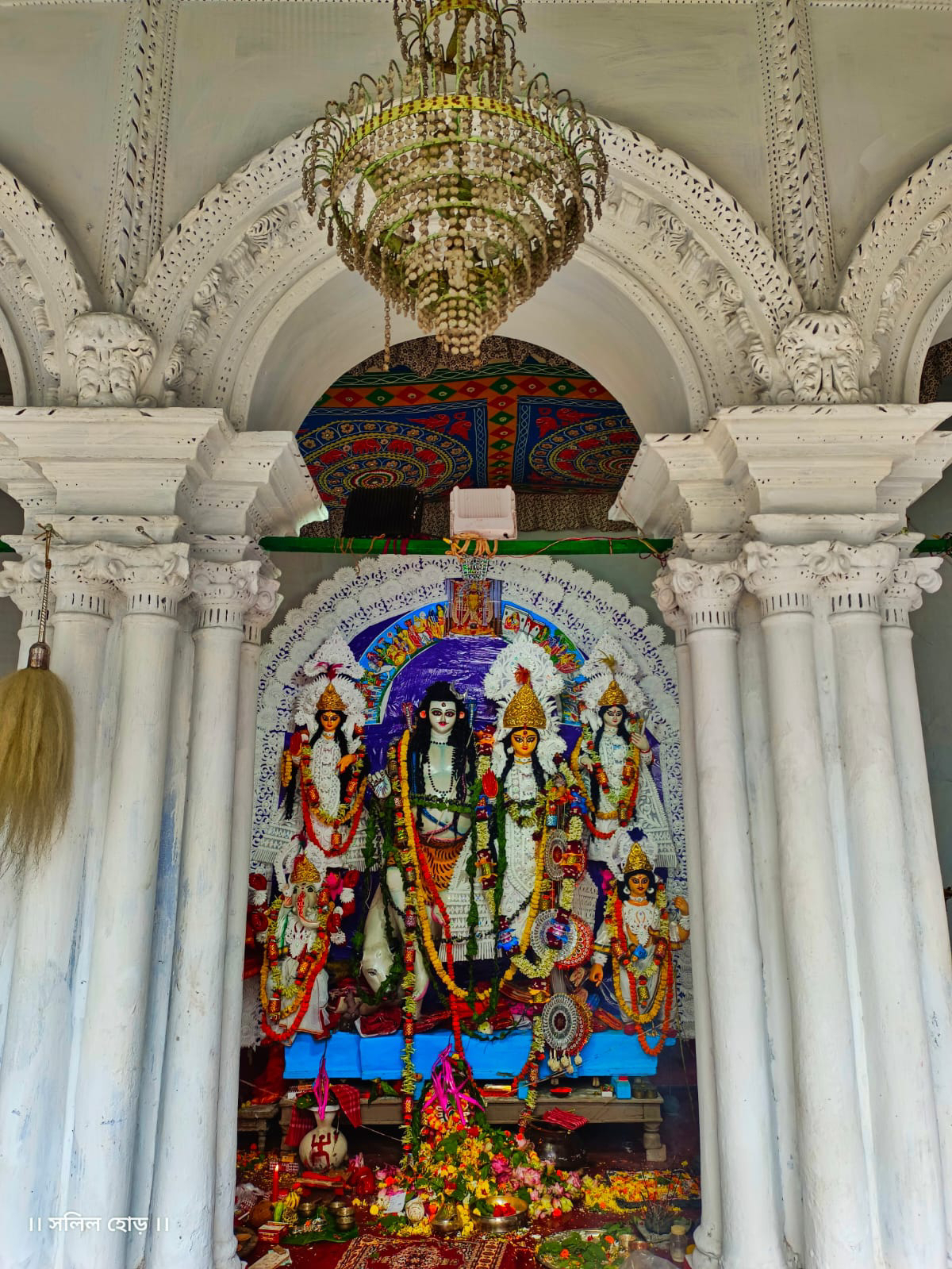কুণ্ডুচৌধুরী বাড়ির দুর্গাপুজো, মহিয়ারি আন্দুল হাওড়া (Durga Puja of Kundu Chowdhury Family, Mohiari Andul Howrah)
আন্দুলের মহিয়ারীর কুণ্ডু চৌধুরীদের কথা আমি প্রথম জানতে পারি, একদিন ঘটনাচক্রে কুণ্ডু চৌধুরী ইনস্টিটিউশনে গিয়ে। এনারদের পরিবারে দুর্গাপুজোর বয়স প্রায় তিনশত বছর। এই বাড়ির পুজোর দুইটি বিশেষত্ব রয়েছে। প্রথমত, এখানে বছরে দুবার দুর্গাপুজো হয় (একবার বাসন্তী পুজো আর শরৎকালে অকাল বোধন দুর্গাপুজো)। দ্বিতীয়ত, এখানে পুজোতে বোট (নৌকো) পুজো করা হয়।
জানা যায়, কুণ্ডুচৌধুরী পরিবারের জমিদারি ছিল বাংলায় মোটামুটি ৭ টি জেলায়... হাওড়া, হুগলি, উত্তর ২৪ পরগনা, দক্ষিণ ২৪ পরগনা, মুর্শিদাবাদ, মেদিনীপুর ও বর্ধমান। পরবর্তীকালে জমিদারি প্রথা বিলুপ্ত হলে, বাড়ির বিভিন্ন পুজোর খরচ চালানোর জন্য ১৯২৭ খ্রিষ্টাব্দে একটা ট্রাস্ট তৈরি করা হয়, এবং সেই ট্রাস্টের দায়িত্বে আজও পুজো সম্পন্ন হচ্ছে।
দুর্গাপুজো আয়োজন শুরু হয় উল্টোরথের দিন, প্রতিমা তৈরির জন্য বাঁশ কাটা দিয়ে। পুজো শুরু হয় মহালয়ার পরের দিন অর্থাৎ প্রতিপদ থেকে, প্রতিদিনের চণ্ডীপাঠের মাধ্যমে। বাড়ির একতলায় ঠাকুরঘরে রয়েছেন লক্ষ্মী জনার্দন, সেখানেই পঞ্চমী পর্যন্ত পুজো হয়। এরপর ষষ্ঠীতে হয় বেলতলাতে পুজো এবং বোধন।
এই বাড়িতে দেবীর হরগৌরি রূপের পুজো হয়। নেই মহিষাসুর বা সিংহ; বরং আছে ষাঁড়ের উপর শিব, আর শিবের কোলে বসে মা দুর্গা। বৈষ্ণব মতে হয় সম্পূর্ণ পুজো, তাই কোনো পশুবলি হয় না। তবে বাতাবি লেবু বলি দেওয়া হয়, কিন্তু জনসমক্ষের আড়ালে। এছাড়াও হয় হরিনাম সংকীর্তন। এখানে চারদিন কুমারী পুজো হয়, সপ্তমী থেকে দশমী পর্যন্ত। অষ্টমীতে বাড়ির মহিলারা ধুনো পোড়ান। তবে এখানে বিশেষত্ব হলো বুট (বোট বা নৌকা) পুজো।
জমিদারির বিভিন্ন প্রয়োজনে এই পরিবারের পুরুষেরা নিয়মিত নৌকায় যাতায়াত করতেন। তখন নদীপথ ছিল দুর্গম; প্রাকৃতিক দুর্যোগের এবং ডাকাতদের ভয় থাকতো। সেই জন্য এই বাড়িতে নৌকা পুজোর সূচনা হয়, যা পরবর্তীকালে লোকমুখে বুটপুজো নামে পরিচিত হয়।
নবমীর সন্ধ্যায় বাড়ির বিবাহিত মহিলারা একটা ছোট প্রতীকী নৌকাকে কড়ি, মুদ্রা, গামছা দিয়ে সাজিয়ে রাখেন। দশমীর দিন সেটিকে পুজো করে, আবার ঠাকুরঘরে বিশেষ স্থানে রেখে দেওয়া হয়; পুনরায় বাসন্তী পুজোর নবমীর দিনে নৌকাটি বের করা হয়।
কুণ্ডুচৌধুরী বাড়িতে বিজয়ার অনুষ্ঠান হয়, সেখানে বাড়ির মেয়েদের তৈরি করা মিষ্টি থাকে, যা ১০০ টি নারকোল থেকে তৈরি করা হয়। প্রসঙ্গত উল্লেখ্য, সমস্ত পুজো পদ্ধতি পারিবারিক ভাবে লিপিবদ্ধ করা আছে 'অর্পণ নামা' নামের একটি বইতে, যেটাকে অনুসরণ করেই সব পুজো করা হয়।
*******************************
The Durga Puja of the Kundu Chowdhury Family in Mohiari, Andul, Howrah
My first encounter with the Kundu Chowdhury family of Mohiari, Andul, occurred serendipitously during a visit to the Kundu Chowdhury Institution. I learned that their family has been celebrating Durga Puja for nearly three centuries. This household's Puja has two distinctive features. Firstly, they observe Durga Puja twice a year – once during the spring (Basanti Puja) and again in the autumn (Akal Bodhan Durga Puja). Secondly, a boat (nouko) is worshipped as part of the rituals.
Historically, the Kundu Chowdhury family held Zamindari (landlordship) over approximately seven districts in Bengal: Howrah, Hooghly, North 24 Parganas, South 24 Parganas, Murshidabad, Medinipur, and Burdwan. Following the abolition of the Zamindari system, a trust was established in 1927 to manage the expenses of the various family Pujas. This trust continues to oversee the Puja celebrations to this day.
The preparations for Durga Puja commence on Ulto Rath (the return journey of the chariots), with the cutting of bamboo for the idol's framework. The Puja rituals begin the day after Mahalaya, from Pratipad (the first day of the lunar fortnight), with daily recitation of the Chandi. The deities Lakshmi Janardan reside in the family's ground-floor shrine, where worship takes place until Panchami (the fifth day). On Shashti (the sixth day), the Bodhan (awakening of the goddess) and subsequent rituals are performed at the Bel tree.
In this household, the Devi is worshipped in her Haragouri form, depicted without Mahishasura (the buffalo demon) or the lion. Instead, Shiva is shown seated on a bull, with Durga seated on his lap. The entire Puja follows Vaishnavite traditions, hence no animal sacrifices are performed. However, a batabi lebu (pomelo) is symbolically offered, albeit privately. Additionally, Harinam Sankirtan (devotional singing) takes place. Kumari Puja (worship of young girls as the goddess) is performed for four days, from Saptami to Dashami. On Ashtami, the women of the household participate in Dhuno Porano (burning incense in earthen pots). A unique aspect here is the worship of a boot (boat or nouko).
Historically, the men of this family regularly traveled by boat for various Zamindari affairs. Riverine routes were perilous at the time, fraught with the dangers of natural calamities and dacoits. To this end, the tradition of boat worship was initiated in this household, later becoming popularly known as Boot Puja.
On the evening of Navami, the married women of the house decorate a small symbolic boat with cowrie shells, coins, and a gamchha (traditional towel). On Dashami, this boat is worshipped and then placed back in a special spot within the shrine. The boat is brought out again on the Navami of the Basanti Puja.
The Bijoya celebrations at the Kundu Chowdhury house feature sweets prepared by the family's women, using approximately 100 coconuts. Notably, the entire Puja procedure is meticulously documented in a book called 'Arpan Nama,' which serves as the guide for all the rituals.







Comments
Post a Comment